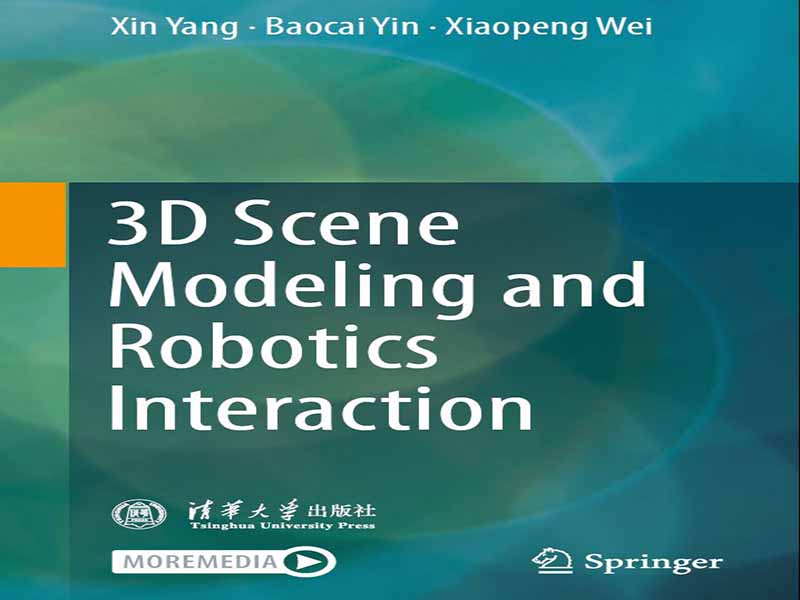- عنوان کتاب: 3D Scene Modeling and Robotics Interaction
- نویسنده: Xin Yang
- سال انتشار: 2025
- حوزه: مدل سه بعدی
- تعداد صفحه: 368
- زبان اصلی: انگلیسی
- نوع فایل: pdf
- حجم فایل: 5.28 مگابایت
شی جین پینگ، دبیرکل حزب کمونیست چین، در گزارش بیستمین کنگره ملی حزب کمونیست چین خاطرنشان کرد: آموزش، علم و فناوری و منابع انسانی، ارکان اساسی و استراتژیک برای ساختن یک کشور سوسیالیستی مدرن در همه زمینهها هستند. ما باید علم و فناوری را به عنوان نیروی مولد اصلی، استعداد را به عنوان منبع اصلی و نوآوری را به عنوان محرک اصلی رشد خود در نظر بگیریم. ما استراتژی تقویت چین را از طریق علم و آموزش، استراتژی توسعه نیروی کار و استراتژی توسعه مبتنی بر نوآوری به طور کامل اجرا خواهیم کرد. ما حوزهها و عرصههای جدیدی را در توسعه باز خواهیم کرد و به طور پیوسته محرکهای رشد جدید و نقاط قوت جدید را پرورش خواهیم داد. این گزارش همچنین تأکید میکند: ما توسعه یکپارچه و خوشهای صنایع نوظهور استراتژیک را ارتقا خواهیم داد و موتورهای رشد جدیدی مانند فناوری اطلاعات نسل بعدی، هوش مصنوعی، بیوتکنولوژی، انرژی جدید، مواد جدید، تجهیزات پیشرفته و صنعت سبز را پرورش خواهیم داد. در حال حاضر، پیشرفت کلی توسعه رشتههای مرتبط با هوش مصنوعی نسل جدید، مدلسازی نظری، نوآوری فناوری، ارتقاء سختافزار و نرمافزار و غیره، باعث ایجاد پیشرفتهای زنجیرهای میشود و انتقال حوزههای مختلف اقتصاد و جامعه را از دیجیتالی شدن و شبکهسازی به هوش تسریع میکند. شی جین پینگ، دبیرکل، در کنفرانس دانشگاهیان آکادمی علوم چین و کنفرانس دانشگاهیان آکادمی مهندسی چین خاطرنشان کرد که رباتها «مروارید تاج صنعت تولید» هستند. رباتهای هوشمند تجسمیافته، به عنوان حاملان فناوری اصلی در زمینه هوش مصنوعی، توانایی تعامل با محیط مانند انسانها، برنامهریزی، تصمیمگیری، عمل و اجرا به صورت مستقل را دارند و نقش مهمی در تأمین نیازهای اصلی کشور، رهبری توسعه اقتصادی ملی و تضمین امنیت دفاعی ملی ایفا میکنند. درک محیط سهبعدی و درک اطلاعات موجود در آن، تجلی مهمی از هوش انسانی و پیشنیاز تعامل آزاد بین انسانها و محیط است. به طور مشابه، رباتهای هوشمند نیز ابتدا باید محیطی را که در آن قرار دارند به طور کامل درک کنند، که اساساً شامل مدلسازی دیجیتال سهبعدی و درک صحنه اطراف است. «چهاردهمین برنامه پنج ساله ملی برای توسعه صنعت ربات» به صراحت بر لزوم تقویت پرورش استعداد رباتیک تأکید میکند. در حال حاضر، اگرچه برخی کتابها شامل برخی از فناوریها هستند، اما هیچ کتاب مرجعی وجود ندارد که به طور سیستماتیک و جامع زمینههای فوق را معرفی کرده و آنها را به یک کل منسجم متصل کند. این کتاب بر ماژول ادراک و تعامل هوشمند در سیستم ربات هوشمند تمرکز دارد، یک سیستم دانش چند رشتهای و یکپارچهسازی متقابل را از منظر مدلسازی و درک صحنه ایجاد میکند، مرزهای فنی و مرزهای تحقیقاتی را تا حد امکان جامع مورد بحث قرار میدهد و بحثهای عملی در مورد ناوبری ربات، اجتناب از مانع، و گرفتن و سایر وظایف کاربردی عملی را انجام میدهد. این کتاب تئوری و عمل را ترکیب میکند و هم الگوریتمهای پایه و هم جدیدترین تکنیکها را با منابع کد یا شبه کد دقیق پوشش میدهد. این کتاب شامل 6 فصل است. فصلهای 1 تا 3 به طور جامع توسعه و کاربرد فناوری مدلسازی و درک صحنه، از جمله هندسه سهبعدی و بازسازی معنایی، کاوش فعال صحنه و درک ساختار صحنه را معرفی میکنند. فصل 1 هندسه سهبعدی و الگوریتمهای بازسازی معنایی مبتنی بر هندسه چندنمایی سنتی و یادگیری عمیق را معرفی میکند و در مورد چگونگی بازیابی ساختار سهبعدی از تصاویر بحث میکند. فصل 2 الگوریتمهای کاوش فعال صحنه را در بازسازی سهبعدی و ناوبری معنایی بصری معرفی میکند و در مورد روشهای مختلف کاوش صحنههای ناشناخته بحث میکند. فصل ۳ دو نوع الگوریتم درک ساختار صحنه مبتنی بر تشخیص و طبقهبندی اشیاء و نمودارهای صحنه را معرفی میکند و روشهای مختلف درک ساختار صحنه را از دو سطح دانش صحنه بدون ساختار و ساختار یافته مورد بحث قرار میدهد. فصلهای ۴ و ۵ به طور جامع توسعه و کاربرد فناوری درک ربات، از جمله تغییر مکان بصری و ناوبری ربات، اجتناب از مانع، گرفتن و غیره را معرفی میکنند. فصل ۴ الگوریتمهای مبتنی بر یادگیری کلاسیک و عمیق مرتبط با تغییر مکان بصری، ناوبری و اجتناب از مانع را معرفی میکند و در مورد چگونگی به دست آوردن وضعیت ژست رباتها و تکمیل وظایف ناوبری و اجتناب از مانع بحث میکند. فصل ۵ روشهای تحلیلی، روشهای تجربی و الگوریتمهای مبتنی بر یادگیری عمیق برای گرفتن و تعامل ربات را معرفی میکند و در مورد روشهای مختلف تشخیص وضعیت گرفتن و گرفتن ربات بحث میکند. فصل ۶ بر درک صحنه سهبعدی برای وظایف تعامل ربات در عمل تمرکز دارد که برای خوانندگان مناسب است تا به طور جامع آن را درک و پردازش کنند.
General Secretary Xi Jinping pointed out in the report of the 20th National Congress of the Communist Party of China: Education, science and technology, and human resources are the foundational and strategic pillars for building a modern socialist country in all respects. We must regard science and technology as our primary productive force, talent as our primary resource, and innovation as our primary driver of growth. We will fully implement the strategy for invigorating China through science and education, the workforce development strategy, and the innovation-driven development strategy. We will open up new areas and new arenas in development and steadily foster new growth drivers and new strengths. The report also emphasizes: We will promote the integrated and clustered development of strategic emerging industries and cultivate new growth engines such as next-generation information technology, artificial intelligence, biotechnology, new energy, new materials, highend equipment, and green industry. At present, the overall advancement of the development of new generation artificial intelligence-related disciplines, theoretical modeling, technological innovation, hardware and software upgrades, etc., is triggering chain breakthroughs, accelerating the transition of various fields of economy and society from digitization and networking to intelligence. General Secretary Xi Jinping pointed out at the Academicians Conference of the Chinese Academy of Sciences and the Academicians Conference of the Chinese Academy of Engineering that robots are the “the pearl on the crown of the manufacturing industry”. Embodied intelligent robots, as carriers of core technology in the field of artificial intelligence, possess the ability to interact with the environment like humans, autonomously plan, decide, act, and execute, playing an important role in serving the country’s major needs, leading the national economic development and ensuring national defense security. Perceiving the 3D environment and understanding the information contained therein is an important manifestation of human intelligence and a prerequisite for free interaction between humans and the environment. Similarly, intelligent robots also need to first fully perceive the environment they are in, which essentially involves 3D digital modeling and understanding of the surrounding scene. The National “14th Five-Year Plan for the Development of the Robot Industry” explicitly states the need to strengthen the cultivation of robotics talent. At present, although some books involve some of the technologies, there is no reference book that systematically and comprehensively introduces the above fields and connects them into a cohesive whole. This book focuses on the intelligent perception and interaction module in the intelligent robot system, establishes a multidisciplinary cross-integration knowledge system, from the perspective of scene modeling and understanding, discusses the technical frontier and research frontier as comprehensively as possible, and carries out practical discussions on robot navigation, obstacle avoidance, and grasping and other practical application tasks. This book combines theory and practice, covering both basic algorithms and the latest techniques, with detailed code or pseudo-code resources. This book consists of 6 chapters. Chapters 1–3 comprehensively introduce the development and application of scene modeling and understanding technology, including 3D geometry and semantic reconstruction, scene active exploration, and scene structure understanding. Chapter 1 introduces 3D geometry and semantic reconstruction algorithms based on traditional multi-view geometry and deep learning, discussing how to recover 3D structure from images. Chapter 2 introduces scene active exploration algorithms in 3D reconstruction and visual semantic navigation, discussing different ways to explore unknown scenes. Chapter 3 introduces two types of scene structure understanding algorithms based on object detection and classification and scene graphs, discussing different ways of scene structure understanding from the two levels of unstructured and structured scene knowledge. Chapters 4 and 5 comprehensively introduce the development and application of robot perception technology, including visual relocalization and robot navigation, obstacle avoidance, grasping, etc. Chapter 4 introduces classic and deep learningbased algorithms related to visual relocalization, navigation, and obstacle avoidance, discussing how robots acquire their own pose status and complete navigation and obstacle avoidance tasks. Chapter 5 introduces analytical methods, empirical methods, and deep learning-based algorithms for robot grasping and interaction, discussing different grasping posture detection and robot grasping methods. Chapter 6 focuses on 3D scene understanding for robot interaction tasks in practice, which is convenient for readers to comprehensively understand and master theory and practice. As for the content of this book, except for Chapter 6, each chapter corresponds to a fixed theme, in which the theory and practice parts are interspersed. In each chapter, the theme is first outlined, the main research work at home and abroad is discussed around this theme, and different technologies are explained according to different methods. The explanation of technology is mainly practical, combined with theoretical knowledge in practice, and “chapter knowledge points” and other characteristic content are designed to facilitate readers to deepen their understanding; each technology includes task description, related work, technical methods, results presentation and summary, etc. The relevant content materials (algorithm code, related papers, etc.) of this book are attached in the form of the SN-branded ShortURLs in each chapter. Tong Li, Xuefeng Yin, Yuanbo Wang, Yuanyuan Liu, Jiajin Qiu, Hu Lin, Zhaoxuan Zhang, Boyan Wei, Zijian Xu, Xiangji Cheng, Yunduo Zhou, Qirui Bao, Xiaochen Shang, Shanglai Qu, Jianchuan Ding, and others from National and Local Joint Engineering Laboratory of Computer Aided Design at Dalian University of Technology participated in the partial organization of this manuscript. Some of the research results in this book originate from National 863 Project “Robot Technology as a Networked and Cloud Computing Terminal,” National Natural Science Foundation of China’s key project “Visual and Semantic-based Indoor Scene Understanding and Real-Time Modeling,” Ministry of Science and Technology’s “Brain Science and Brain-like Research” Major Program “Design and Application of Multi-modal and Multi-scale Synergistic Neuroplasticity Brain-like Reinforcement Learning Network Model,” National Natural Science Foundation of China’s Major Research Program cultivation project “Research on Natural Interaction Methods for Co-Integrated Robots for Dynamic Unstructured Environments,” National Natural Science Foundation of China’s General Program “Research on Fast Visual Re-localization Methods for Building Interior Scenes under High-speed and Complex Lighting Environments,” and Dalian Jieqing Program “Intelligent Sensing and Decision Making System for Bionic Robots.” This book can serve as a teaching reference book in the fields of information and intelligence related majors, computer graphics, computer vision, and intelligent robots in higher education institutions, and can also be used as a reference for professionals in related fields. In the field of artificial intelligence, the development of scene modeling and robot perception technology is advancing rapidly. Although this book strives to be comprehensive and closely follow its development trend, due to the limited level and time of the authors, there are inevitably omissions in the book. Readers are kindly encouraged to provide feedback and corrections.
این کتاب را میتوانید از لینک زیر بصورت رایگان دانلود کنید:



































نظرات کاربران